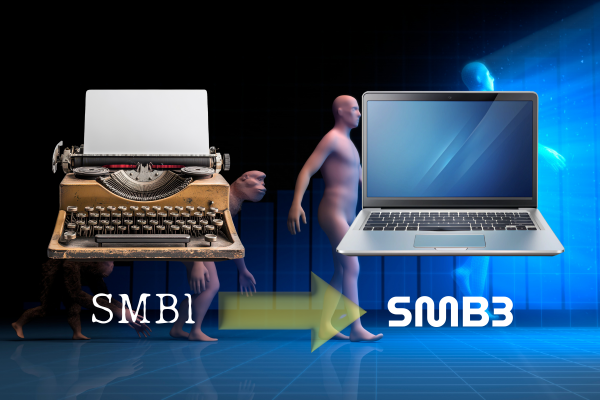Migrating from SMB1 to SMB3 is crucial for maintaining the security and efficiency of your systems. Microsoft stopped supporting SMB1 in 2016 due to its vulnerabilities, which means that continuing to use it exposes your network to significant security risks. By transitioning to SMB3, you can take advantage of enhanced security features such as encryption and improved data integrity.
Moreover, SMB3 offers better performance and reliability. This is particularly important in industries like Smart Factory and Industry 4.0, where seamless and quick communication between devices is essential for operational efficiency. With SMB3, you also get better support for modern operating systems, which ensures that your legacy systems can still communicate effectively without compromising on performance.
In addition, migrating to SMB3 helps future-proof your infrastructure. As technology evolves, sticking with outdated protocols can hinder your ability to integrate new systems and technologies. Upgrading to SMB3 ensures that your systems remain compatible with future advancements, making it easier to scale and adapt to new industry standards.
Overall, moving from SMB1 to SMB3 is a strategic decision that enhances security, improves performance, and ensures long-term compatibility with modern and future technologies.

What Are the Challenges of Migrating from SMB1 to SMB3?
Migrating from SMB1 to SMB3 is a critical step toward modernizing IT infrastructure, but it comes with its fair share of challenges. One of the most significant hurdles is compatibility. Many legacy systems, particularly in industries like manufacturing and Industry 4.0 environments, still rely heavily on SMB1. These systems are often deeply integrated into daily operations, and upgrading them to support the more modern SMB3 protocol can be a daunting task. Think of SMB1 and SMB3 as two different languages; in order to establish a seamless connection between them, a “simultaneous translator” is required. This translation often involves custom configurations or middleware solutions, adding complexity to the migration process.
Another major challenge is the need for specialized technical expertise. Transitioning from SMB1 to SMB3 is far from a simple update; it requires a deep understanding of the SMB protocol and the specific nuances of your existing systems. The migration may seem straightforward, but in reality, it can take years of development and requires an in-depth knowledge of protocol intricacies. This often means that in-house IT teams need to either upskill or bring in external consultants, both of which can be time-consuming and expensive.
The migration process itself can also lead to operational disruptions. During the transition, systems might be temporarily offline or function at reduced capacity. This is particularly concerning in environments that rely on continuous uptime, such as Smart Factories and Industrial IoT (IIoT) applications. Any downtime can directly impact productivity and operational efficiency, posing significant risks to businesses that cannot afford interruptions.
Moreover, upgrading to SMB3 isn’t just a technical challenge; it has licensing implications as well. SMB3 incorporates enhanced features that come with Intellectual Property (IP) obligations, particularly with Microsoft. Ensuring compliance with these obligations is crucial to avoid legal risks, maintain smooth operations, and safeguard your organization from potential penalties or disruptions.
Finally, security is a key concern throughout the migration process. While SMB3 offers robust security enhancements, the transition must be carefully managed to avoid introducing new vulnerabilities. Maintaining data integrity and ensuring that security protocols are consistently applied during and after the migration is essential to protect sensitive information.
How Does Visuality Systems Facilitate the Transition?
Migrating from SMB1 to SMB3 can seem like a daunting task, but that’s where Visuality Systems comes in. Our expertise in Server Message Block (SMB) protocol solutions ensures a smooth and secure transition for your company. Let’s break down how we make this process manageable and efficient.
Overview of Visuality Systems’ Solutions
Visuality Systems offers a comprehensive suite of solutions designed to help several industries, including Smart Factory, Industry 4.0, Manufacturing, and IIoT migrate from SMB1 to SMB3. Our technology supports a wide range of operating systems, including Windows CE, VxWorks, QNX, and Linux, which are commonly used in manufacturing systems like HMI panels, robots, CNC machines, PLCs, SCADA, and Automated Guided Vehicles (AGV).
Our flagship product, YNQ, provides robust SMB3 client and server capabilities. YNQ is a C-based library that integrates seamlessly with various embedded systems. This product ensures that your legacy systems can communicate effectively with modern infrastructure, enhancing both security and performance.
Step-by-Step Migration Process
Visuality Systems makes the transition from SMB1 to SMB3 straightforward through a well-defined migration process. Here’s a step-by-step look at how we facilitate this:
- Assessment and Planning: The first step involves assessing your current systems to understand the extent of SMB1 usage and planning the migration accordingly. This includes identifying all devices and applications that rely on SMB1.
- Customization and Integration: Visuality Systems provides tailored solutions to fit your specific needs. Whether you’re using embedded devices or mobile applications, our technology can be ported to ensure compatibility and seamless integration.
- Implementation: Once the customization is complete, the implementation phase begins. This involves installing the YNQ or jNQ libraries and configuring them to replace SMB1 with SMB3. Visuality Systems’ engineers offer support throughout this process, ensuring that everything runs smoothly.
- Testing and Validation: After implementation, rigorous testing is conducted to validate the new setup. This step is crucial to ensure that all systems are communicating correctly and that there are no security vulnerabilities.
- Training and Support: Visuality Systems doesn’t just leave you to fend for yourself after the migration. We provide training for your staff to understand the new system and offer ongoing support to address any issues that may arise.
By following this structured approach, Visuality Systems ensures that your transition from SMB1 to SMB3 is efficient and hassle-free. Our solutions not only help you move away from outdated protocols but also enhance your overall system performance and security.
If you’re looking for reliable SMB1 migration solutions, Visuality Systems has the expertise and technology to help you make the switch seamlessly.
Which Industries Benefit Most from SMB1 to SMB3 Migration?
Migrating from SMB1 to SMB3 is particularly crucial for several key industries. In the manufacturing sector, for example, many systems like HMI panels, robots, CNC machines, and PLCs rely on secure and efficient communication protocols. Upgrading to SMB3 ensures these systems can operate seamlessly with modern infrastructure, enhancing both security and performance.
The automotive industry also stands to gain significantly from this migration. Modern vehicles and manufacturing plants utilize a plethora of embedded systems that need to communicate reliably and securely. SMB3 provides the robust framework necessary to support these complex operations.
In the realm of Smart Factory and Industry 4.0, the transition to SMB3 is a game-changer. These industries depend heavily on interconnected devices and systems to optimize production and reduce downtime. By adopting SMB3, they can ensure better interoperability and data integrity, which are critical for maintaining efficient operations.
Finally, the IIoT (Industrial Internet of Things) sector benefits immensely from moving to SMB3. Devices in this field often require real-time data exchange and high security. SMB3’s advanced features, such as encryption and improved data handling, make it the ideal protocol to support the growing demands of IIoT applications.
How Do Operating Systems Affect the Migration?
When you’re dealing with the migration from SMB1 to SMB3, the operating systems in use play a crucial role. Different operating systems have varying levels of support for SMB dialects, which can significantly impact the migration process.
For instance, if your systems run on Windows CE, VxWorks, QNX, or Linux, you need to ensure that these platforms are compatible with SMB3. Each of these operating systems has its own way of handling SMB protocols, and they might require specific adjustments or updates to support SMB3 effectively.
In manufacturing environments, where you’re likely working with HMI panels, robots, CNC machines, PLCs, and SCADA systems, compatibility with SMB3 is essential. These systems often run on a mix of older and newer operating systems, making the migration process more complex. Ensuring that all systems can communicate seamlessly using SMB3 is key to maintaining operational efficiency and security.
Visuality Systems can help smooth out this process. Our technology supports a wide range of operating systems, ensuring seamless upgrade from SMB1 used in legacy systems to SMB3 supported by modern systems. By leveraging our expertise, you can make the transition smoother and more efficient, minimizing downtime and maintaining the integrity of your operations.
Summary and Final Thoughts
Migrating from SMB1 to SMB3 is crucial for modernizing your systems and ensuring security. Visuality Systems provides the expertise and tools needed to make this transition seamless. By upgrading to SMB3, your system components can benefit from enhanced performance, better security features, and improved interoperability with modern systems. Whether you’re in manufacturing, Smart Factory, or IIoT, making this move can significantly enhance your operational efficiency. Trust Visuality Systems to guide you through this essential upgrade, ensuring that your legacy systems can communicate effectively with newer technologies.
Raphael Barki, Head of Marketing, Visuality Systems





